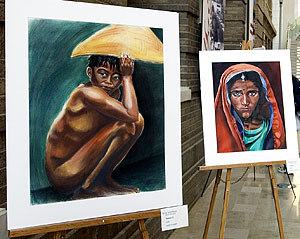The School of Medicine Arts Commission, an umbrella group that coordinates various artistic efforts, is facilitating an art show in the Farrell Learning and Teaching Center through March 15 featuring 65 artists.
The show features paintings, photographs, sculptures and three-dimensional pieces crafted by students from various programs in the medical school, faculty, staff and alumni, said Andy Leitner and Jeremy Orr, second-year medical students who are coordinating the show. The pieces represent an array of creativity and expression, with some relating to medicine, including a mixed media and collage piece on endometrial cancer by Paul Goodfellow, Ph.D., professor of genetics, of surgery and of obstetrics and gynecology, and his wife, Carol Stewart, as well as an electronic art piece done by Gavin Perry, supervisor of electronics and maintenance in the machine shop.

In November 2004, second-year students organized an art show at the Bernard Becker Medical Library’s King Center. In order to keep the show going, students, faculty and staff formed the Arts Commission to tie together the various artistic events on the medical campus and encourage interaction between the students and faculty outside of the classroom or clinical settings, Orr and Leitner said.
In addition to the art show, the Arts Commission sponsors informal Coffeehouse Concerts a few times a semester, where student and faculty musicians perform. It also supports Hippocrene, an annual literary magazine that includes poetry, short stories and other submissions and is distributed to current and prospective students, faculty and staff. The commission is also putting on Guys and Dolls, April 7, 8 and 15, for which students are making their own sets and costumes.
Much of the funding for the commission’s art show, plays and presentations comes from the Alumni Association.
“A gift from an anonymous donor to support art in the Farrell Learning and Teaching Center really sparked enthusiasm and a groundswell of interest in the arts,” said Leslie Kahl, M.D., associate dean for student affairs and professor of medicine.
Orr said the gift was perfect timing, because several students had the idea to start the commission, which was able to use some of the funds to buy various supplies, including an artwork display system and art supplies.
“Once the funding was established, we were amazed at the autonomy we were given,” Leitner said.
Morton E. Smith, M.D., professor emeritus of ophthalmology and visual sciences and associate dean emeritus, and Carl Frieden, Ph.D., professor of biochemistry and molecular biophysics, are faculty advisers to the commission, which has about 20 active members.
“It is a given that Washington University medical students have the most impressive credentials compared to medical students at other schools,” Smith said. “But what we are so proud of here is the extracurricular talents that these students have, especially in the creative arts.”
Many of the commission’s events are held at the Farrell Center, which Leitner described as the “arts commission playground.” The commission was involved in selecting the art displayed throughout the building as well as in selecting the grand piano for the second floor.
Orr and Leitner are artists themselves — Orr is a guitarist and Leitner is a pianist — so they know firsthand the tie between art and medicine.
“There is an important balance between the scientific and humanistic sides of medicine,” Leitner said. “The skills involved in creating and enjoying art are similar to medicine — observation, analysis and technical skills. You can use art to hone your skills in areas that will have a direct impact on how you ultimately deal with patients.”